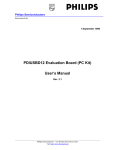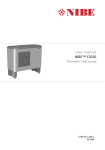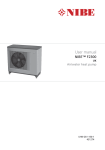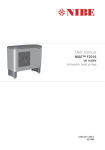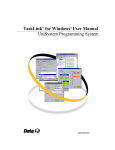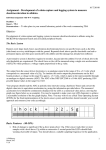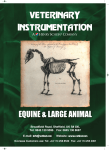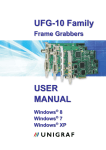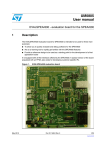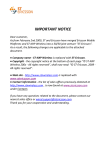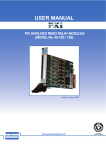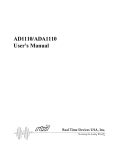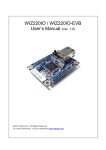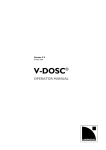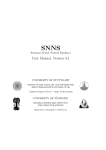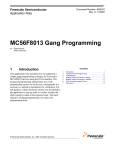Download User`s Manual
Transcript
Philips Semiconductors Connectivity and Interoperability Solutions PDIUSBD12 Evaluation Board (PC Kit) User’s Manual Rev. 2.1 _______________________________________________________________________________________________ Philips Semiconductors - Asia Product Innovation Centre Visit http://www.flexiusb.com Philips Semiconductors Connectivity and Interoperability Solutions This is a legal agreement between you (either an individual or an entity) and Philips Semiconductors. By accepting this product, you indicate your agreement to the disclaimer specified as follows: DISCLAIMER PRODUCT IS DEEMED ACCEPTED BY RECIPIENT. THE PRODUCT IS PROVIDED “AS IS” WITHOUT WARRANTY OF ANY KIND. TO THE MAXIMUM EXTENT PERMITTED BY APPLICABLE LAW, PHILIPS SEMICONDUCTORS FURTHER DISCLAIMS ALL WARRANTIES, INCLUDING WITHOUT LIMITATION ANY IMPLIED WARRANTIES OF MERCHANT ABILITY, FITNESS FOR A PARTICULAR PURPOSE, AND NONINFRINGEMENT. THE ENTIRE RISK ARISING OUT OF THE USE OR PERFORMANCE OF THE PRODUCT AND DOCUMENTATION REMAINS WITH THE RECIPIENT. TO THE MAXIMUM EXTENT PERMITTED BY APPLICABLE LAW, IN NO EVENT SHALL PHILIPS SEMICONDUCTORS OR ITS SUPPLIERS BE LIABLE FOR ANY CONSEQUENTIAL, INCIDENTAL, DIRECT, INDIRECT, SPECIAL, PUNITIVE, OR OTHER DAMAGES WHATSOEVER (INCLUDING, WITHOUT LIMITATION, DAMAGES FOR LOSS OF BUSINESS PROFITS, BUSINESS INTERRUPTION, LOSS OF BUSINESS INFORMATION, OR OTHER PECUNIARY LOSS) ARISING OUT OF THIS AGREEMENT OR THE USE OF OR INABILITY TO USE THE PRODUCT, EVEN IF PHILIPS SEMICONDUCTORS HAS BEEN ADVISED OF THE POSSIBILITY OF SUCH DAMAGES. _______________________________________________________________________________________________ Philips Semiconductors - Asia Product Innovation Centre Visit http://www.flexiusb.com Connectivity and Interoperability Solutions USER’S MANUAL 09/01/98 Page 1 REV. 2.1 TABLE OF CONTENTS DISCLAIMER ............................................................................................................. 2 TABLE OF CONTENTS ............................................................................................. 1 INSTALLATION OF PDIUSBD12 EVALUATION BOARD ........................................ 2 Introduction ................................................................................................................... ....................................... 2 System Requirements............................................................................................................ ............................... 2 Installation ................................................................................................................... ......................................... 3 Jumper’s setting on PDIUSBD12 ISA bridging board............................................................................... ........ 3 Location of key components on the PDIUSBD12 evaluation board. ................................................................. 4 Installation of firmware, INF and driver ....................................................................................... ..................... 5 Using the Host Applet .......................................................................................................... ................................ 5 HARDWARE DESCRIPTION..................................................................................... 7 Block Diagram .................................................................................................................. .................................... 7 I/O Mapping .................................................................................................................... ..................................... 7 Connectors ..................................................................................................................... ....................................... 8 PAL Equations.................................................................................................................. .................................... 9 Address and command decoder.................................................................................................... ...................... 9 Schematics..................................................................................................................... ...................................... 10 Schematics for PDIUSBD12 evaluation board...................................................................................... ........... 10 Schematic for PDIUSBD12 ISA bridging board..................................................................................... ......... 11 Bill of Materials .................................................................................................................................................. 12 Bill of materials of the PDIUSBD12 evaluation board .................................................................................... 12 Bill of materials of the PDIUSBD12 ISA bridging board ................................................................................ 12 _______________________________________________________________________________________________ Philips Semiconductors - Asia Product Innovation Centre Visit http://www.flexiusb.com Connectivity and Interoperability Solutions Page 2 09/01/98 USER’S MANUAL REV. 2.1 INSTALLATION OF PDIUSBD12 EVALUATION BOARD Introduction The PDIUSBD12 evaluation kit uses 2 PC as a complete USB development environment, a host PC with USB host capability and a device PC running PDIUSBD12’s firmware. The PDIUSBD12 ISA bridging board is plugged inside the device PC and connects to the evaluation board using a 25-wire cable. So the device PC behaves as a big USB device. Features evaluation of PDIUSBD12, firmware and product prototype development can be easily done with this setup, without the resource limitation of a micro-controller. Customers can also connect the evaluation board to their own CPU and bus through the 25-wire cable for final product development. The firmware is carefully developed for high rate data transmission and is written in C, that supports Borland Turbo C for x86 and Keil C51 for 8031 currently. Supporting to other CPU platforms will be available soon. System Requirements 1. 2. 3. 4. 5. 6. PDIUSBD12 evaluation board and ISA bridging board; 25-wire shielding data switch cable; Host PC with USB motherboard or add-on card; Microsoft Windows 98 or Windows NT 5.0 Beta 2; Device PC running Microsoft DOS 6.x; PDIUSBD12 evaluation diskette. For firmware development: 1. X86 CPU platform: Borland Turbo C++ 3.0 or above; 2. 8031: Keil C51 4.0 or above. PDIUSBD12 Evaluation Disk D1 D1 2TE S 2 D1 TES T.EX 2T T.S E ES T.I YS NF E .EX 2FW D1 USB Cable 25-Wire Cable D12 Mouse Device PC with PDIUSBD12 ISA Bridging Board Mouse PDIUSBD12 Evaluation Board Host PC with USB host Controller _______________________________________________________________________________________________ Philips Semiconductors - Asia Product Innovation Centre Visit http://www.flexiusb.com Connectivity and Interoperability Solutions Page 3 09/01/98 USER’S MANUAL REV. 2.1 Installation Jumper’s setting on PDIUSBD12 ISA bridging board The PDIUSBD12 ISA bridging board is plugged inside the device PC. It will occupy I/O, IRQ and DMA resources of the device PC. To avoid possible conflicts in settings, we suggest removal of all the unnecessary cards from the device PC. Sound card and network card may cause conflict in IRQ and DMA setting. J2 ON JP5 JP6 S1 1 8 JP1 JP2 JP3 JP4 Switch S1 sets the base I/O address for the D12 evaluation board. Default base address is 0x368. The D12 evaluation board occupies 8 I/O locations. A0 to A2 are decoded on the D12 evaluation board. Switch S1 sets the address decoding of A3 to A9. Please notice that a switch ‘ON’ is logic ‘0’. SW(n) Address Default 1 X OFF 2 A3 OFF 3 A4 ON 4 A5 OFF 5 A6 OFF 6 A7 ON 7 A8 OFF 8 A9 OFF Jumpers JP1 and JP2 set the IRQ number for the D12 evaluation board. Default setting is IRQ5 or JP1 is shorted. IRQ Number Jumper’s Setting Default IRQ5 JP1 ON IRQ7 JP2 OFF Jumpers JP3 to JP6 set the DMA number for the D12 evaluation board. Default setting is DMA3 or JP4 and JP6 are shorted. Please note that a respective pair of jumpers is needed to set a particular DMA channel. DMA Number Jumper’s Setting Default DMA1 JP3, JP5 OFF, OFF DMA3 JP4, JP6 ON, ON Possible conflict table: _______________________________________________________________________________________________ Philips Semiconductors - Asia Product Innovation Centre Visit http://www.flexiusb.com Connectivity and Interoperability Solutions USER’S MANUAL IRQ or DMA Number IRQ5 IRQ7 DMA1 DMA3 Page 4 09/01/98 REV. 2.1 Possible Conflict Creative SoundBlaster™ and compatible sound cards always occupy this IRQ by default. If this kind of sound card is installed, you should check its settings or remove it. Some network cards may also use this IRQ. Used by parallel port by default. May cause printing problem on device PC. Creative SoundBlaster™ and compatible sound cards always occupy this DMA by default. If this kind of sound card is installed, you should check its settings or remove it. No conflict. Location of key components on the PDIUSBD12 evaluation board. J1 D1 J2 J3 D5 D4 D3 D2 S4 S3 S2 S1 See the table below for the list of connectors. Connector J1 J2 J3 Descriptions USB upstream connector DB25 data bus connector Extension board connector See the table below for the list of switch and LEDs. Name S1, S2, S3, S4 D1 D2, D3, D4, D5 Descriptions Test switches GoodLink™ LED Test LEDs _______________________________________________________________________________________________ Philips Semiconductors - Asia Product Innovation Centre Visit http://www.flexiusb.com Connectivity and Interoperability Solutions 09/01/98 USER’S MANUAL Page 5 REV. 2.1 Installation of firmware, INF and driver The firmware, D12FW.EXE, runs on the device PC under DOS mode. When D12FW starts, it lights up test LEDs on the evaluation board for 1 second. This means that the I/O address setting is correct. TM And the evaluation board is disconnected and re-connected to USB by SoftConnect . If this is the first time that the evaluation board is connected to host PC, host OS Device Manager will prompt installation of INF and driver. Select the location of D12TEST.INF and D12TEST.SYS and complete installation procedure. Some useful key command is supported when the firmware is running. Key ESC ENTER i v Operation Disconnect USB and quit PDIUSBD12 firmware. TM Reconnect USB using SoftConnect . Display firmware status information. Switch on/off verbose mode, normally turned off for faster operation. Using the Host Applet The test applet, D12TEST.EXE, exercises all PDIUSBD12 endpoints. Testing of control endpoints can be further done by standard USB Chapter 9 test programs. The operation of each endpoint is designed according to its nature that is supported in PDIUSBD12. Generic in and generic out endpoints has max packet size of 16 bytes and supports I/O access only. So they are suitable for small size and low rate data transfer like keyboard and logic controls. The main endpoints have max packet size of 64 bytes or 128 bytes with double buffering and DMA support. So they are suitable for high data rate, large size data transfer. See the table below for the description of endpoints operations on PDIUSBD12 evaluation board. _______________________________________________________________________________________________ Philips Semiconductors - Asia Product Innovation Centre Visit http://www.flexiusb.com Connectivity and Interoperability Solutions USER’S MANUAL Endpoint Number 1 Endpoint Type Generic In 1 Generic Out 2 Main In Main Out 09/01/98 Page 6 REV. 2.1 Operations This pipe is defined as Interrupt In pipe. The PDIUSBD12 evaluation board sends key press/release data packet to the host when test keys are pressed or released. The firmware uses I/O accesses on this endpoint. This pipe is defined as Interrupt Out pipe. Data packet received from host is interpreted as LED control and the D12 evaluation board firmware will light up the corresponding LED. The firmware uses I/O accesses on this endpoint. These pipes are defined as Bulk In/Out endpoints. Test applet and the PDIUSBD12 evaluation board supports 3 test modes: loop-back mode, print mode and scan mode. The firmware uses DMA for data transfer on these endpoints. Main endpoints support 3 different test modes: 1. Scan mode: The PDIUSBD12 evaluation board acts like a scanner. It sends data packets to the host PC as fast as possible. This mode is used to evaluate the maximal Bulk In transfer rate. 2. Print mode: The PDIUSBD12 evaluation board acts like a printer. It receives data packets from the host PC as fast as possible. This mode is used to evaluate the maximal Bulk Out transfer rate. 3. Loop back mode: In this mode, the PDIUSBD12 evaluation board receives data packets on Main Out endpoint and sends them back to the host PC on Main In endpoint. This mode is used to test the data integrity of transfers. The “Buffer Size” setting on the test applet is determined by the firmware and hardware ability of the evaluation board. For PC kit, the maximal size is limited to 64000; On USB-EPP kit, this is limited to 16384. The “Repeat Times” for loop-back test controls the numbers of iterations of loop-back, which is useful for debugging. “-1” means it is infinite. _______________________________________________________________________________________________ Philips Semiconductors - Asia Product Innovation Centre Visit http://www.flexiusb.com Connectivity and Interoperability Solutions Page 7 09/01/98 USER’S MANUAL REV. 2.1 HARDWARE DESCRIPTION System Block Diagram of D12 Evaluation Kit On USB host side, a sample application program D12TEST.EXE and a general purpose minidriver D12TEST.SYS are provided. USB Host PC 25 Pin Interface 1. VCC, GND 2. D0 - D7 3. ADDRESS ENABLE 4. IOW, IOR, IRQ, RESET 5. DREQ, DACK, EOT D12 Sample Applet D12TEST.EXE Customer’s System On device side, sample firmware D12FW.EXE is provided for running on device PC. The firmware is written in C for easily portable to other CPU platforms. 25 Pin I/F CPU, Memory, and DMA Controller D12 Evaluation Board USB Device PC D12 Sample Driver D12TEST.SYS Test Key General Input port Test LED General Output port Command and Address Decoder 25 Pin I/F D12 ISA Bridging Board USBD USB Host Controller Driver 25 Pin I/F Bi-direction Bus Transceiver PDIUSBD12 USB Host Controller ISA Slot DIP Switches and Jumpers Block Diagram Above block diagram shows 5 main components on the PDIUSBD12 evaluation board. Beside bus transceiver, address/command decoder and PDIUSBD12, a general input port and a general output port are included in the design. These input and output ports are designed for test purposes, such as test switches and test LEDs. They also act as glue logic to adapt the PDIUSBD12 to the ISA bus. For example, ISA interrupt is edge triggered, but PDIUSBD12 interrupt is level triggered. The MSB of the general output port is used as interrupt enable to convert level triggered interrupt to edge triggered. I/O Mapping PDIUSBD12 evaluation board uses 8 I/O addresses: Offset 0 1 2 3 4 to 7 Usage D12 data register, R/W D12 command register, W only General input port, R only General output port, W only Reserved for expansion board Bit description for general input port: _______________________________________________________________________________________________ Philips Semiconductors - Asia Product Innovation Centre Visit http://www.flexiusb.com Connectivity and Interoperability Solutions USER’S MANUAL Bit 0 1 2 3 4 5 6 7 Page 8 09/01/98 REV. 2.1 Usage Key S1, ‘0’ for pressed Key S2, ‘0’ for pressed Key S3, ‘0’ for pressed Key S4, ‘0’ for pressed TM pin state D12 GoodLink USB bus power state, ‘1’ for USB VBUS present D12 SUSPEND pin state D12 INT_N pin state Bit description for general output port: Bit 0 1 2 3 4 5 6 7 Usage LED D2, ‘1’ lights up LED LED D3, ‘1’ lights up LED LED D4, ‘1’ lights up LED LED D5, ‘1’ lights up LED Reserved Reserved Suspend control, ‘1’ forces D12 SUSPEND pin low Interrupt enable, ‘1’ enables interrupt Connectors 25 wire connector for PDIUSBD12 evaluation board: Pin 1 2 3 4 5 6 7 8 9 10 Type POWER POWER I/O I/O I/O I/O I/O O I/O I 11 12 I/O I 13 14 I/O I 15 16 I/O I 17 18 I/O I 19 I Description VCC GND DATA7 Zero Wait State DATA6 Reserved DATA5 CLKOUT: This line is connected to PDIUSBD12 CLKOUT pin. DATA4 -AD_EN: This line is the decoder output for address decoding A3 to A9. This signal is active low when PDIUSBD12 evaluation board I/O address is selected. DATA3 RESET: This line is used to reset or initialize system logic upon power-up and is active high. DATA2 -IOW: This command line instructs an I/O device to read the data on the data bus. It may be driven by the processor or the DMA controller. This signal is active low. DATA1 -IOR: This command line instructs an I/O device to drive its data onto the data bus. It may be driven by the processor or the DMA controller. This signal is active low. DATA0 T/C, Terminal Count: This line provides a pulse when terminal count for any DMA channel is reached. This signal is active high. ADDR2 _______________________________________________________________________________________________ Philips Semiconductors - Asia Product Innovation Centre Visit http://www.flexiusb.com Connectivity and Interoperability Solutions USER’S MANUAL 20 I 21 22 I O 23 24 I O 25 POWER Page 9 09/01/98 REV. 2.1 -DACK: This line is used to acknowledge DMA request and is active low. ADDR1 DRQ: This line is asynchronous channel request used by peripheral devices to gain DMA service. A DMA request is generated by bringing DRQ line to an active high. ADDR0 IRQ: This line is raising edge triggered. An interrupt request is generated by raising this line high and hold until it is acknowledged by the processor. GND PAL Equations Address and command decoder /** Inputs **/ Pin 1 = ADDR2; Pin 2 = ADDR1; Pin 3 = ADDR0; Pin 4 = !IOW; Pin 5 = !IOR; Pin 6 = !DACK; Pin 7 = !AD_EN; Pin 8 = RESET; Pin 9 = INT_N; Pin 11 = INT_EN; /** Outputs **/ Pin 12 = IRQ; Pin 13 = RESET_N; Pin 14 = RD_N; Pin 15 = WAIT; Pin 16 = !CS_D12; Pin 17 = !WR_273; Pin 18 = !RD_244; Pin 19 = !DIR_245; /** Logic Equations **/ !DIR_245 = (!AD_EN & !DACK) # !IOR # RESET; !RD_244 = !AD_EN # !(!ADDR2 & ADDR1 & !ADDR0) # !IOR; !WR_273 = !AD_EN # !(!ADDR2 & ADDR1 & ADDR0) # !IOW; !CS_D12 = !AD_EN # !(!ADDR2 & !ADDR1) # (!IOW & !IOR); RESET_N = !RESET; IRQ = !INT_N & INT_EN; WAIT.OE = CS_D12; WAIT = RESET; RD_N = !IOR; _______________________________________________________________________________________________ Philips Semiconductors - Asia Product Innovation Centre Visit http://www.flexiusb.com Connectivity and Interoperability Solutions Page 10 09/01/98 USER’S MANUAL REV. 2.1 Schematics Schematics for PDIUSBD12 evaluation board + V CC C1 4.7 TA NT C13 S5 V _BUS V CC R1 470 BUS POWERED J2 DB25 1 3 5 7 9 11 13 15 17 19 21 23 25 Shell t o DATA[0..7] DA TA 7 DA TA 6 DA TA 5 DA TA 4 DA TA 3 DA TA 2 DA TA 1 DA TA 0 A DDR2 A DDR1 A DDR0 R4 R5 4.7K 4.7K 2 4 6 8 10 12 14 16 18 20 22 24 V CC CLKOUT -A D_EN RESET -IOW -IOR T/C -DA CK DRQ IRQ GND 470P, Cer amic PDIUSBD12 U1 1 D0 A0 2 DA TA 0 D1 V OUT3.3 3 DA TA 1 D2 D+ 4 DA TA 2 D3 D5 DA TA 3 V CC 6 GND D4 XTA L2 7 DA TA 4 D5 XTA L1 8 DA TA 5 D6 GL_N 9 DA TA 6 D7 RESET_N 10 DA TA 7 EOT_N 11 A LE -CS_D12 CS_N DMACK_N SUSPEND 12 DMREQ 13 SUSPEND CLKOUT WR_N INT_N 14 INT_N RD_N C3 0.1 D1 GREEN 28 27 26 25 24 23 22 21 20 19 18 17 16 15 A DDR0 J1 1 2 3 4 5 R2 22 1% Y 1 6MHz XTA L2 XTA L1 C16 0.1 22 1% C5 47P -DA CK DRQ -IOW -IOR R7 R8 R9 R10 10K 10K 10K 10K C6 22P OSC1 4 G O V BUS DD+ GND SHIELD UP_CONN L2 Fer rite Bead R3 C14 0.1 V CC 5 V CC 1 19 1 A1 A2 A3 A4 A5 A6 A7 A8 B1 B2 B3 B4 B5 B6 B7 B8 G DIR 18 17 16 15 14 13 12 11 D0 D1 D2 D3 D4 D5 D6 D7 D0 D1 D2 D3 D4 D5 D6 D8 D7 U2 74LS245 -DIR_245 1 2 3 4 5 6 7 8 9 11 A DDR2 A DDR1 A DDR0 -IOW -IOR -DA CK -A D_EN RESET I1 I2 I3 I4 I5 I6 I7 I8 I9 I10 O1 O2 O3 O4 O5 O6 O7 O8 19 18 17 16 15 14 13 12 18 16 14 12 9 7 5 3 1Y 1 1Y 2 1Y 3 1Y 4 2Y 1 2Y 2 2Y 3 2Y 4 1A 1 1A 2 1A 3 1A 4 2A 1 2A 2 2A 3 2A 4 1G 2G D[0..7 ] 2 3 4 5 6 7 8 9 DA TA 0 DA TA 1 DA TA 2 DA TA 3 DA TA 4 DA TA 5 DA TA 6 DA TA 7 C15 1000P L1 Fer rite Bead V _BUS + C2 4.7 TA NT -RD_EV A L -WR_EV AL -CS_D12 ZERO_WA IT D0 D1 D2 D3 D4 D5 D6 D7 RESET_N IRQ U5 16L8 INT_EN INT_N 3 4 7 8 13 14 17 18 11 1 D1 D2 D3 D4 D5 D6 D7 D8 S3 Q1 Q2 Q3 Q4 Q5 Q6 Q7 Q8 S4 * OSC1 is optional r eplacement for Y1, C5 and C6. R11 1K 1 2 5 6 9 12 15 16 19 2 R12 470 R16 1M U4A 74LS05 V CC R13 470 D2 RED D3 RED R14 470 D4 RED 4 U4C 74LS05 5 13 6 12 9 8 U4D 74LS05 V CC 11 D7 D6 D5 D4 D3 D2 D1 D0 1 3 5 7 9 11 13 15 17 19 J3 CON20A 2 4 6 8 10 12 14 16 18 20 CLKOUT INT_N RESET_N -A D_EN -IOW -IOR A DDR2 A DDR1 A DDR0 10 U6 74HCT273 C8 0.1 C9 0.1 C10 0.1 C11 0.1 C12 0.1 R15 470 D5 RED U4B 74LS05 3 U4F 74LS05 CLK CLR S1 8 V _BUS 1 19 U3 74HCT244 N V S2 2 4 6 8 11 13 15 17 U4E 74LS05 V CC Title D12 EVA LUA TION BOARD + C7 10 TA NT Size A Date: Document Number D12-EVA L-200 Thur sday, A pril 23, 19 98 Rev 2.00 Sheet 1 of 1 _______________________________________________________________________________________________ Philips Semiconductors - Asia Product Innovation Centre Visit http://www.flexiusb.com Connectivity and Interoperability Solutions Page 11 09/01/98 USER’S MANUAL REV. 2.1 Schematic for PDIUSBD12 ISA bridging board VCC J2 DB25 J1 CON AT62 A1 A2 A3 A4 A5 A6 A7 A8 A9 A10 A11 A12 A13 A14 A15 A16 A17 A18 A19 A20 A21 A22 A23 A24 A25 A26 A27 A28 A29 A30 A31 DA TA[0..7] DA TA7 DA TA6 DA TA5 DA TA4 DA TA3 DA TA2 DA TA1 DA TA0 ADDR2 ADDR1 ADDR0 RP1 20K S1 SW DIP-8 8 7 6 5 4 3 2 1 VCC 8 7 6 5 4 3 2 1 B1 B2 B3 B4 B5 B6 B7 B8 B9 B10 B11 B12 B13 B14 B15 B16 B17 B18 B19 B20 B21 B22 B23 B24 B25 B26 B27 B28 B29 B30 B31 I/O CH CK DATA7 DATA6 DATA5 DATA4 DATA3 DATA2 DATA1 DATA0 I/O CH RDY AEN ADDR19 ADDR18 ADDR17 ADDR16 ADDR15 ADDR14 ADDR13 ADDR12 ADDR11 ADDR10 ADDR9 ADDR8 ADDR7 ADDR6 ADDR5 ADDR4 ADDR3 ADDR2 ADDR1 ADDR0 7 6 5 4 3 2 1 C GND V CC RESET +5V IRQ2 -5V DRQ2 -12 V ZERO_WA IT +12V GND -MEMW -MEMR -IOW -IOR -DA CK3 DRQ3 -DA CK1 DRQ1 -DACK0 CLOCK IRQ7 IRQ6 IRQ5 IRQ4 IRQ3 -DACK2 T/C V CC ALE +5V OSC GND U1 1 9 10 11 12 13 14 15 16 18 16 14 12 9 7 5 3 17 15 13 11 8 6 4 2 G VCC Q7 Q6 Q5 Q4 Q3 Q2 Q1 Q0 P7 P6 P5 P4 P3 P2 P1 P0 C1 0.1 2 4 6 8 10 12 14 16 18 20 22 24 ZERO_WA IT -A D_EN V CC RESET -IOW -IOR R1 T/C -DACK 10K DRQ IRQ GND IRQ5 IRQ7 JP1 JP2 DRQ1 DRQ3 -DA CK1 -DA CK3 P=Q 19 JP3 JP4 JP5 JP6 -AD_EN 74HCT688 ADDR[0..2] VCC + C2 4.7u 1 3 5 7 9 11 13 15 17 19 21 23 25 Shell t o V CC + C3 4.7u C4 0.1 C5 0.1 Title D12 ISA BRIDGING BOARD Size A Date: Document Number D12-ISA -200 Tuesday , Februar y 24 , 1998 Rev 2.00 Sheet 1 of 1 _______________________________________________________________________________________________ Philips Semiconductors - Asia Product Innovation Centre Visit http://www.flexiusb.com Connectivity and Interoperability Solutions 09/01/98 USER’S MANUAL Page 12 REV. 2.1 Bill of Materials Bill of materials of the PDIUSBD12 evaluation board Item 1 2 3 4 5 6 7 8 9 10 11 12 13 14 15 16 17 18 19 20 21 22 23 24 25 26 27 28 29 Quantity 2 8 1 1 1 1 1 1 4 1 1 1 2 1 5 2 2 4 1 1 4 1 1 1 1 1 1 1 1 Reference C2,C1 C3,C8,C9,C10,C11,C12,C14,C16 C5 C6 C7 C13 C15 D1 D2,D3,D4,D5 J1 J2 J3 L1,L2 OSC1 R1,R12,R13,R14,R15 R2,R3 R4,R5 R7,R8,R9,R10 R11 R16 S1,S2,S3,S4 S5 U1 U2 U3 U4 U5 U6 Y1 Part 4.7 TANT 0.1 47P 22P 10 TANT 470P, Ceramic 1000P GREEN RED UP_CONN DB25 CON20A Ferrite Bead Crystal Oscillator 470 22 1% 4.7K 10K 1K 1M SW PUSHBUTTON BUS POWERED PDIUSBD12 74LS245 74HCT244 74LS05 16L8 74HCT273 6MHz Bill of materials of the PDIUSBD12 ISA bridging board Item 1 2 3 4 5 6 7 8 9 Quantity 3 2 6 1 1 1 1 1 1 Reference C1,C4,C5 C2,C3 JP1,JP2,JP3,JP4,JP5,JP6 J1 J2 RP1 R1 S1 U1 Part 0.1 4.7u JUMPER CON AT62 DB25 20K 10K SW DIP-8 74HCT688 _______________________________________________________________________________________________ Philips Semiconductors - Asia Product Innovation Centre Visit http://www.flexiusb.com














